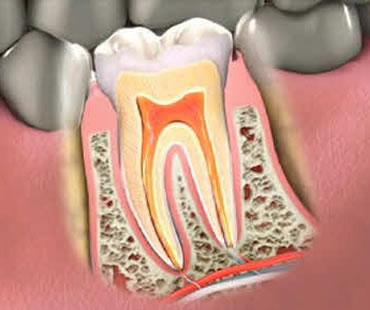
Endodontics is a dental term often linked to a more common dental procedure you’ve probably already heard of called root canal treatment. Endodontics focuses on the pulp of your tooth, which holds nerves and blood vessels supplying nutrients and oxygen to your tooth. When the pulp is infected or injured, endodontic treatment may be performed to save the tooth.
During endodontic treatment, the hollow part inside your tooth is cleaned, disinfected, and filled. It is often the best way to save a tooth that has been damaged by decay, trauma, or other causes. Common symptoms that endodontic treatment is necessary include pain, tooth sensitivity, or exposure of the pulp due to tooth fracture.
After examining your tooth and X-ray results, your dentist will recommend the kind of endodontic treatment you need based on how seriously the pulp is impacted. One type is called vital pulp therapy, which has a goal of preserving and protecting your tooth’s pulp. This procedure involves removing only the pulp from the crown of your tooth and not from the root. It is only advised when there is no swelling or abscess present, and the tooth is secure.
Another type of endodontic treatment is non-vital pulp therapy, which is known as root canal treatment. It is performed when there is no chance of saving the pulp of your tooth. The whole pulp will be removed from inside your tooth, and the canals will be cleaned and filled with a special material. Then a stainless steel crown will be placed on the tooth.
Sometimes endodontic treatment is not recommended, and the tooth needs to be extracted instead. This choice depends on factors such as tooth location, age of the tooth, extent of damage, and the patient’s overall health. Your dentist will be able to advise you on the best treatment for your condition.
If you live in the Fernandina Beach area contact us today

An endodontist is a dentist who has undergone additional training specializing in saving teeth through treatments that involve the pulp and root of teeth. If you have been diagnosed by your family dentist with an infected tooth that requires root canal therapy, it would be logical to seek treatment by a dental professional who is specifically trained in root canal procedures. To find a qualified endodontist for your root canal treatment, consider the following:
- Ask for a referral from your family dentist to an accredited diplomate of the American Board of Endodontics. You may also consider asking friends and family members who have undergone root canal therapy for recommendations of endodontists.
- Inquire about the extent of the endodontist’s education and training as well as the number of root canal procedures they have performed. You will want to look for a doctor with an established practice and extensive track record of root canal experience.
- Find out what type of equipment the doctor utilizes to ensure they are up-to-date on the most recent advances in endodontic therapy and dental technology.
- Ask about the sedation and pain-relief options the endodontist provides for root canal patients.
- Evaluate the endodontist and staff to determine if they make you feel comfortable, welcome, and are able and available to answer your questions.
Root canal treatment can be a stress-free and painless experience when performed by the right dental professional. Taking the time and effort to identify a qualified endodontist will help to ensure the ease and success of your procedure, and soon have you back on the road to a healthy smile.
Root canal dentist in Fernandina Beach

Are you unhappy with the appearance of your smile? Will the improvements you desire need multiple dentistry treatments to achieve the results you are seeking? You may be an ideal candidate for a smile makeover. A smile makeover is a process in which a number of cosmetic dentistry treatments are combined to perfect your smile. Usually, a smile makeover will include options like teeth whitening, dental bonding, porcelain veneers, invisible braces, composite fillings or gum contouring.
Broadly, anyone who has problems with their teeth is a candidate for a smile makeover. However, the best candidate for a smile makeover will be in good general and oral health. You should be free from gum disease and any other ailments or health problems that would preclude undergoing cosmetic dentistry procedures. An ideal candidate will also have grown in all permanent teeth and completed their jaw growth, making a smile makeover inappropriate for young children.
You may be an ideal candidate for a smile makeover if your smile is marred by a number of imperfections including:
- Discolored or stained teeth
- Chipped or cracked teeth
- Crooked, twisted, or incorrectly placed teeth
- Decayed teeth
- Gapped or widely-spaced teeth
- Gummy smile
- Unhealthy gums
- Bite conditions such as overbite or underbite
The appearance and health of your smile are vital to your self-confidence and overall happiness. Smile makeovers are safe and effective for most candidates, with little to no side effects. To determine if a smile makeover is right for you, contact an experienced, qualified cosmetic dentist for a one-on-one consultation.
We look forward to seeing you in our Fernandina Beach dental office

Millions of root canal treatments are performed every year, and it is an effective and safe way to save a damaged tooth. Unlike its reputation over the years, modern dentistry allows this procedure to be practically painless and to provide relief from symptoms right away.
Anatomy
The first thing to understand is the anatomy of the tooth. Under the hard enamel on the outside of the tooth and the dentin below that, the interior of a tooth contains pulp. It houses the nerves, blood vessels, and connective tissues that all nourish the tooth. This allows it to grow properly and contributes to good oral health. After the tooth is fully developed, the tooth can get its nourishment from surrounding tissues and the pulp is not as necessary.
Necessity
The pulp can become infected, inflamed, or damaged by problems like decay, injury, repeated dental procedures, or a bad crown. If the damaged pulp is not treated, an abscess can develop or severe pain can result. Often, root canal treatment is the only way to save the tooth instead of having to extract it. Dentists advise that saving a tooth is almost always a better option, providing the most natural appearance, efficient function, and protection of oral health.
Procedure
Many patients report that root canal treatment is not much different for them than having a regular filling done. X-rays are taken and a local anesthetic is administered. Once numb, a dental dam is placed to protect the area during the procedure. Then the pulp is removed, the area is thoroughly cleaned, and then it is filled with special material for this purpose. The tooth is sealed for protection, and finally a crown is placed on top to protect the tooth. Most patients are able to return to normal activities immediately following treatment, and the procedure is permanent in most cases.
If you need a root canal dentist in Fernandina Beach, contact our office today.

Having a bright, beautiful, white smile is something we all desire. It signals health and prosperity and leaves the best possible first impression a person can make. There are a host of products at the drug store that label themselves “whitening.” Whitening toothpastes, whitening mouth rinses, whitening strips, gels and creams all line the shelves, promising a “new you!” Your dentist, however, offers something labeled as “bleaching.” So what’s the difference? Which should you choose?
Your natural tooth is made up of two specific layers: enamel and dentin. The enamel layer is on the outside of the tooth. It’s the white part we see when someone smiles. It’s hard and heavily mineralized and can appear like porcelain. The dentin is the inner layer. It’s yellow in color and supports the enamel on the outside. Over time, your enamel naturally wears away and the yellow dentin color can begin to show through.
The term “whitening” is applied to any product that helps restore teeth to a natural color by removing debris and stains from a natural tooth’s surface. Any substance that restores the surface of a tooth’s enamel is a whitening product. Many whitening products contain a mild abrasive that removes leftover discoloration and food particles, leaving the enamel of the tooth smooth and white. Teeth whitening products combat stains caused by ageing and the discoloration left by many foods, or by smoking.
The FDA permits the term “bleaching” only for products that can whiten a tooth beyond their initial, natural color. Bleaching products contain active ingredients such as carbamide peroxide or hydrogen peroxide. The peroxide is activated so that it releases oxygen molecules that enter the tooth enamel and break down stains in a way that whitening products cannot. This activation can occur immediately, in the case of some in-office bleaching products, like laser whitening, or it can take several hours, as it can with custom take-home bleaching trays.
If you are considering brightening your smile, talk to Fernandina Beach teeth whitening dentist Dr. Kitson to see what product is best suited to your smile needs!
We look forward to seeing you in our Fernandina Beach dental office

Each year, more than 30,000 Americans receive an oral cancer diagnosis. Unfortunately, less than 57 percent will live beyond five years. In fact, the death rate for oral cancer is higher than cervical cancer, Hodgkin’s disease, brain cancer, and liver cancer. Usually seen in older patients, oral cancer in individuals under 40 is on the rise.
Fast Facts about Oral Cancer
• Early detection increases the survival rate to almost 90 percent.
• Initially, oral cancer patients may have few obvious symptoms of the illness.
• Certain factors, such as gender, lifestyle choices, and age can increase your risk of developing oral cancer. An estimated 25 percent of oral cancer patients, however, have no risk factors for the disease.
• Famous people who have battled oral cancer include Michael Douglas, Roger Ebert, Aaron Spelling, Humphrey Bogart, Eddie Van Halen, and Babe Ruth.
• Signs of oral cancer include a sore that does not heal after two weeks, color change in oral tissue, hoarse or scratchy throat, and difficulty with chewing or swallowing.
• Side effects of oral cancer may include chronic discomfort, loss of oral function, and difficulty in chewing, swallowing, or speaking.
• Research suggests that a diet rich in fruits and vegetables decreases your chances of developing cancerous lesions.
• Routine dental visits allow your dentist to look for signs of oral cancer, which can lead to early detection if there is a problem.
• Tobacco and alcohol use can result in a 75 percent chance of receiving an oral cancer diagnosis.
We look forward to seeing you in our Fernandina Beach dental office







